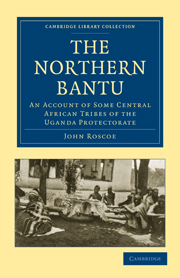Book contents
- Frontmatter
- PREFACE
- Contents
- LIST OF ILLUSTRATIONS
- Uganda and British East Africa
- PART I THE BANYORO A PASTORAL PEOPLE
- PART II THE BANYANKOLE A PASTORAL TRIBE OF ANKOLE
- PART III THE BAKENE, LAKE DWELLERS
- PART IV THE BAGESU A CANNIBAL TRIBE
- CHAP. XV THE BAGESU, CULTIVATION, FOOD AND GOVERNMENT
- CHAP. XVI MARRIAGE, BIRTH, SICKNESS AND DEATH
- CHAP. XVII RELIGIOUS BELIEFS
- CHAP. XVIII MUSIC, DANCING, WARFARE, BUILDING, AMUSEMENTS AND HUNTING
- PART V THE BASOGA
- PART VI NILOTIC TRIBES. THE BATESO AND THE KAVIRONDO
- INDEX
- PUBLICATIONS OF THE CAMBRIDGE UNIVERSITY PRESS RELATING TO AFRICA
- Plate section
CHAP. XVIII - MUSIC, DANCING, WARFARE, BUILDING, AMUSEMENTS AND HUNTING
Published online by Cambridge University Press: 07 September 2011
- Frontmatter
- PREFACE
- Contents
- LIST OF ILLUSTRATIONS
- Uganda and British East Africa
- PART I THE BANYORO A PASTORAL PEOPLE
- PART II THE BANYANKOLE A PASTORAL TRIBE OF ANKOLE
- PART III THE BAKENE, LAKE DWELLERS
- PART IV THE BAGESU A CANNIBAL TRIBE
- CHAP. XV THE BAGESU, CULTIVATION, FOOD AND GOVERNMENT
- CHAP. XVI MARRIAGE, BIRTH, SICKNESS AND DEATH
- CHAP. XVII RELIGIOUS BELIEFS
- CHAP. XVIII MUSIC, DANCING, WARFARE, BUILDING, AMUSEMENTS AND HUNTING
- PART V THE BASOGA
- PART VI NILOTIC TRIBES. THE BATESO AND THE KAVIRONDO
- INDEX
- PUBLICATIONS OF THE CAMBRIDGE UNIVERSITY PRESS RELATING TO AFRICA
- Plate section
Summary
Musical instruments. These people are fond of music: they have a primitive harp, and also a rude kind of drum which accompanies songs and dances. The harp is used to accompany songs in the house, but is not used in public songs and dances. In dances the drum only is used, and bells, attached to the thighs and to the ankles, are made to clang by stamping the feet to the rhythm of the drum. Songs are sung during the dances, which take place almost monthly when the moon is nearing the full and the evenings are light. Girls make a small instrument of reeds after the pattern of a zither. This instrument is used by a girl as she sings her love ditties.
Dancing and the use of the thigh bells. In dances both men and women take part and form sides, the men use the thigh bells and stamp with their feet to make the bells sound and produce a thud from the stamp; the women only sing as they dance. The parties move in circles as they dance, or march from opposite sides of a square to meet in the middle and retreat. The season most devoted to dances is after harvest when each village is able to make its brew of beer and contribute to the village supply for the dancing.
- Type
- Chapter
- Information
- The Northern BantuAn Account of Some Central African Tribes of the Uganda Protectorate, pp. 189 - 194Publisher: Cambridge University PressPrint publication year: 2010First published in: 1915



